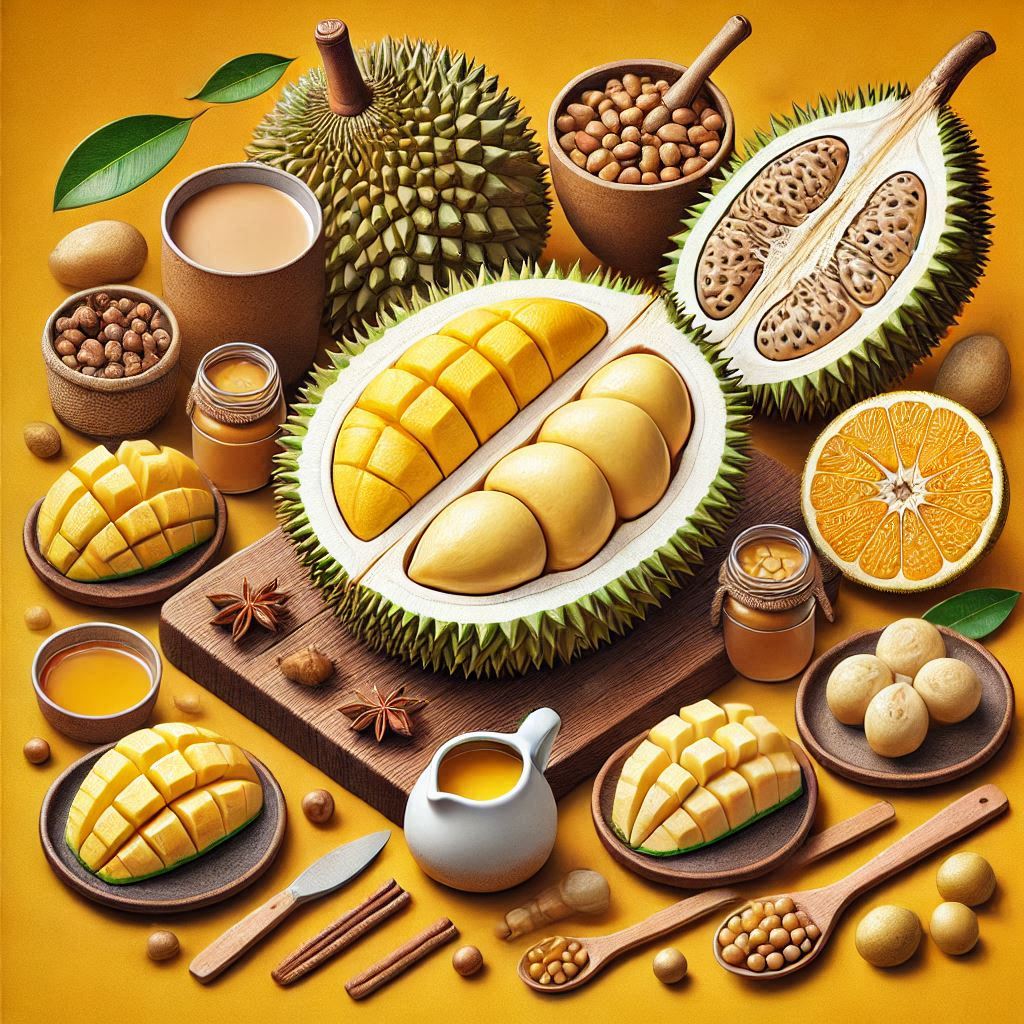
Introduction: Why Distinguishing Between Durian and Jackfruit Matters
When it comes to tropical fruits, durian and jackfruit often capture the curiosity of food enthusiasts around the world. While both are unique in their own right, distinguishing between these two fruits is essential for several reasons. Firstly, understanding the differences in taste, texture, and aroma can enhance your culinary experiences. Durian is famous for its strong odor and creamy texture, often described as a mix of savory and sweet flavors. In contrast, jackfruit offers a milder scent with a fibrous texture and a sweet taste reminiscent of bananas or pineapples.
Moreover, accurate fruit identification is crucial for those with dietary preferences or restrictions. Both fruits offer distinct nutritional benefits; however, they are used differently in cooking due to their unique properties. Jackfruit’s versatility makes it an excellent meat substitute in vegan dishes because of its ability to absorb flavors well when cooked. On the other hand, durian is typically enjoyed fresh or as an ingredient in desserts due to its rich flavor profile.
Finally, differentiating between durian and jackfruit matters from an ecological perspective as well. Both fruits play significant roles in their native ecosystems but require different growing conditions and care practices when cultivated commercially. By learning more about these fascinating tropical fruits—durian vs jackfruit—you can appreciate not only their culinary uses but also their cultural significance across various regions where they thrive naturally.
Appearance: Identifying Features That Set Them Apart
When it comes to distinguishing between durians and jackfruits, their unique appearances serve as the first point of differentiation. Both are large tropical fruits with a spiky exterior, but closer inspection reveals distinct characteristics that set them apart.
The durian, often dubbed the “king of fruits,” is renowned for its formidable spikes that cover its husk. These spikes are sharp and closely packed, making the fruit look almost intimidating. Durians typically have a round to oblong shape and range in size from small to medium-large. Their color varies from green to brown as they ripen.
In contrast, the jackfruit is generally larger than the durian and boasts a more elongated or oval form. While it also features a spiky surface, the spikes on a jackfruit are less pronounced and softer compared to those on a durian. The skin of a ripe jackfruit turns from green to yellowish-brown as it matures.
Both fruits share similarities in their spiky appearance, but their size, shape, and spike texture provide clear visual cues for identification. Understanding these differences can help fruit enthusiasts easily tell these two exotic fruits apart at first glance.
Aroma: The Notorious Scent of Durian vs the Mild Fragrance of Jackfruit
When it comes to tropical fruits, few are as polarizing as the durian and jackfruit, particularly when considering their distinct aromas. The durian is infamous for its overpowering scent, often described as a potent mix of sulfur, onions, and raw sewage. This strong fruit scent has led to its ban in many public places across Southeast Asia. Despite its notorious reputation, many enthusiasts appreciate the durian’s unique aroma and flavor.
In contrast, the jackfruit offers a much milder fragrance that is generally more palatable to the unaccustomed nose. Its smell is sweet and musky, reminiscent of a blend between bananas and pineapples. This subtle aroma makes jackfruit an easier introduction for those unfamiliar with tropical fruits.
In a fruit aroma comparison between these two giants of the tropics, it’s clear that while both have distinctive scents that set them apart from other fruits, they cater to different olfactory preferences. Whether you prefer the bold durian smell or the gentle jackfruit fragrance largely depends on your personal taste and sense of adventure in exploring exotic flavors.
Taste Profile: Understanding Their Distinct Flavors and Textures
When exploring the rich world of tropical fruits, durian and jackfruit often stand out due to their unique taste profiles and textures. Understanding these differences can enhance your appreciation for these exotic delights.
Durian is renowned for its distinctive aroma and complex flavor. The durian taste is a combination of sweet, savory, and slightly bitter notes. Its creamy texture adds to its allure, making it a favorite among those who enjoy rich and bold flavors. The flesh is custard-like, providing an indulgent experience that contrasts sharply with its spiky exterior.
In contrast, jackfruit offers a milder yet equally intriguing profile. The jackfruit taste is predominantly sweet with hints of mango or banana-like undertones. Its texture varies depending on ripeness; when ripe, it has a fibrous yet juicy consistency that makes it perfect for both fresh consumption and culinary applications like desserts or smoothies.
The flavor differences in tropical fruits like durian and jackfruit highlight the diverse spectrum found within this fruit category. While durian captivates with its creamy intensity, jackfruit charms with its sweet versatility. Whether you’re drawn to the boldness of durian or the approachable nature of jackfruit, both offer unique experiences worth exploring in your culinary adventures.
Nutritional Value: Health Benefits and Dietary Considerations of Each Fruit
When exploring the nutritional value of tropical fruits, durian and jackfruit stand out not only for their unique flavors but also for their health benefits. Both fruits are packed with essential vitamins and minerals, yet they offer distinct nutritional profiles that cater to different dietary needs.
Durian is rich in energy-providing carbohydrates and contains a good amount of dietary fiber, which aids in digestion. It also boasts a significant presence of vitamins such as vitamin C, which supports the immune system, and vitamin B complex including niacin, riboflavin, and thiamine that play crucial roles in energy metabolism.
On the other hand, jackfruit is known for its impressive vitamin A content along with moderate levels of vitamin C. Vitamin A is vital for maintaining healthy vision and skin integrity. Additionally, jackfruit provides a substantial amount of potassium—a mineral important for heart health—and antioxidants like carotenoids that help protect against cellular damage.
In terms of health benefits, both durian and jackfruit contribute positively to overall well-being. Durian’s rich nutrient profile can aid in improving digestive health due to its fiber content while supporting energy levels through its carbohydrate composition. Jackfruit’s high antioxidant levels make it an excellent choice for boosting immune function and promoting healthy skin.
When making a nutritional comparison between durian and jackfruit, it’s clear that each fruit offers unique advantages depending on one’s dietary goals. Whether you’re looking to enhance your intake of specific vitamins or seeking natural sources of energy and antioxidants, incorporating these tropical delights into your diet can be both beneficial and delicious.
Culinary Uses: How Different Cultures Incorporate These Fruits into Dishes
The culinary uses of durian and jackfruit are as diverse and fascinating as the cultures that embrace them. These tropical fruits, known for their unique flavors and textures, have carved out a special place in kitchens around the world, each culture adding its own twist to how these fruits are prepared and enjoyed.
In Southeast Asia, durian is often hailed as the “king of fruits” and is used in a variety of sweet and savory dishes. In Thailand, durian is commonly incorporated into desserts such as sticky rice with coconut milk or ice cream, where its creamy texture complements the sweetness of these treats. Meanwhile, in Malaysia, it finds its way into savory curries where its strong aroma adds depth to rich sauces.
Jackfruit’s versatility shines through in Indian cuisine where it is used both ripe and unripe. Young jackfruit’s fibrous texture makes it an excellent meat substitute in vegetarian curries like Kathal Ki Sabzi or Pulled Jackfruit Tacos—a nod to fusion cooking that blends traditional ingredients with contemporary recipes. Ripe jackfruit is often enjoyed fresh or added to sweet dishes like Payasam in South India.
In Western countries, both fruits are gaining popularity for their exotic appeal. Chefs experiment with them by creating innovative recipes that highlight their unique properties—think jackfruit BBQ sandwiches or durian-flavored pastries.
Cooking with exotic fruits like durian and jackfruit not only introduces new flavors but also offers a glimpse into diverse culinary traditions around the globe. As more people discover these tropical treasures, they continue to inspire creativity in kitchens everywhere, bridging cultural gaps through shared gastronomic experiences.






